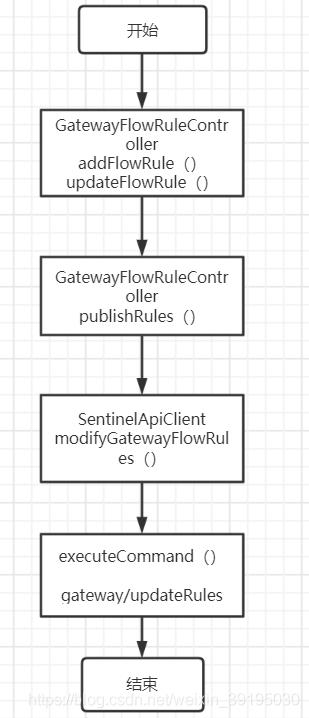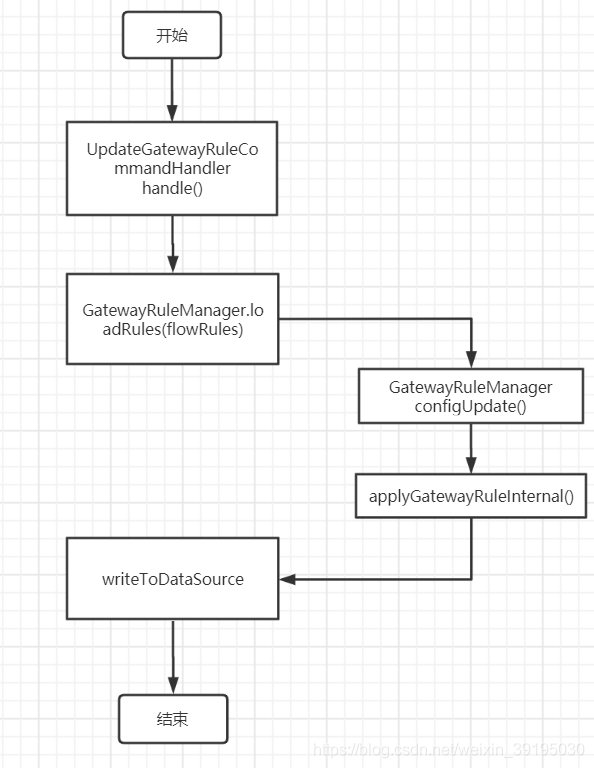жӮЁеҘҪпјҢзҷ»еҪ•еҗҺжүҚиғҪдёӢи®ўеҚ•е“ҰпјҒ
жӮЁеҘҪпјҢзҷ»еҪ•еҗҺжүҚиғҪдёӢи®ўеҚ•е“ҰпјҒ
иҝҷзҜҮж–Үз« дё»иҰҒи®Іи§ЈдәҶвҖңSentinel DashboardйҷҗжөҒ规еҲҷдҝқеӯҳж–№жі•жңүе“ӘдәӣвҖқпјҢж–Үдёӯзҡ„и®Іи§ЈеҶ…е®№з®ҖеҚ•жё…жҷ°пјҢжҳ“дәҺеӯҰд№ дёҺзҗҶи§ЈпјҢдёӢйқўиҜ·еӨ§е®¶и·ҹзқҖе°Ҹзј–зҡ„жҖқи·Ҝж…ўж…ўж·ұе…ҘпјҢдёҖиө·жқҘз ”з©¶е’ҢеӯҰд№ вҖңSentinel DashboardйҷҗжөҒ规еҲҷдҝқеӯҳж–№жі•жңүе“ӘдәӣвҖқеҗ§пјҒ
sentinelеңЁйҷҗжөҒ规еҲҷй…ҚзҪ®ж–№йқўжҸҗдҫӣдәҶеҸҜи§ҶеҢ–йЎөйқў sentinel dashboardпјҢжәҗз ҒеҸҜд»ҺgithubдёӢиҪҪпјҢиҜ·иҮӘиЎҢжҗңзҙўпјҢжӯӨеӨ„дёҚжҸҗдҫӣдёӢиҪҪй“ҫжҺҘгҖӮ
规еҲҷжҢҒд№…еҢ–еҗҺйҰ–е…Ҳи§ҰеҸ‘GatewayFlowRuleControllerпјҲжәҗз Ғдјјд№ҺжІЎжңүпјҢиҜ·еҸӮиҖғжҷ®йҖҡ规еҲҷж”№йҖ пјүзҡ„/new.jsonпјҲжҲ–пјүиҜ·жұӮпјҢж–№жі•дјҡи°ғз”ЁpublishRules()е°Ҷжң¬ж¬Ўзј–иҫ‘规еҲҷз»„иЈ…еҗҺйҖҡиҝҮиҝңзЁӢи°ғз”ЁиҜ·жұӮgateway/updateRulesжӣҙж–°иҝңзЁӢжңҚеҠЎеҶ…еӯҳдёӯйҷҗжөҒ规еҲҷпјҢиҜҘжҺҘеҸЈз”ұиҝңзЁӢжңҚеҠЎUpdateGatewayRuleCommandHandlerжҸҗдҫӣгҖӮ
UpdateGatewayRuleCommandHandlerжҺҘ收еҲ°иҜ·жұӮйҖҡиҝҮи°ғз”Ёhandleж–№жі•пјҢж–№жі•йҖҡиҝҮ
Set<GatewayFlowRule> flowRules = (Set)JSON.parseObject(data, new TypeReference<Set<GatewayFlowRule>>() {
}, new Feature[0]);
GatewayRuleManager.loadRules(flowRules);е°Ҷ规еҲҷжҢҒд№…еҢ–еҲ°еҶ…еӯҳгҖӮ
Sentinel DashBoardзЁӢеәҸжөҒзЁӢ

GatewayзҪ‘е…ізЁӢеәҸжөҒзЁӢ

<li ui-sref-active="active">
<a ui-sref="dashboard.flowV1({app: entry.app})">
<i class="glyphicon glyphicon-filter"></i> жөҒжҺ§и§„еҲҷ
</a>
</li>ж”№дёәпјҡ
<li ui-sref-active="active">
<a ui-sref="dashboard.flow({app: entry.app})">
<i class="glyphicon glyphicon-filter"></i> жөҒжҺ§и§„еҲҷ
</a>
</li>2гҖҒе°Ҷwebapp\resources\app\scripts\controllers\identity.jsдёӯзҡ„пјҲдё»иҰҒжҳҜе°ҶFlowServiceV1ж”№дёәFlowServiceV2пјү
app.controller('IdentityCtl', ['$scope', '$stateParams', 'IdentityService',
'ngDialog', 'FlowServiceV1', 'DegradeService', 'AuthorityRuleService', 'ParamFlowService', 'MachineService',
'$interval', '$location', '$timeout',
function ($scope, $stateParams, IdentityService, ngDialog,
FlowService, DegradeService, AuthorityRuleService, ParamFlowService, MachineService, $interval, $location, $timeout) {ж”№дёәпјҡ
app.controller('IdentityCtl', ['$scope', '$stateParams', 'IdentityService',
'ngDialog', 'FlowServiceV2', 'DegradeService', 'AuthorityRuleService', 'ParamFlowService', 'MachineService',
'$interval', '$location', '$timeout',
function ($scope, $stateParams, IdentityService, ngDialog,
FlowService, DegradeService, AuthorityRuleService, ParamFlowService, MachineService, $interval, $location, $timeout) {FlowRuleNacosProvider.java (д»ҺnacosиҜ»еҸ–й…ҚзҪ®)
package com.alibaba.csp.sentinel.dashboard.rule;
import java.util.ArrayList;
import java.util.List;
import com.alibaba.csp.sentinel.dashboard.datasource.entity.rule.FlowRuleEntity;
import com.alibaba.csp.sentinel.dashboard.rule.DynamicRuleProvider;
import com.alibaba.csp.sentinel.datasource.Converter;
import com.alibaba.csp.sentinel.util.StringUtil;
import com.alibaba.nacos.api.config.ConfigService;
import org.springframework.beans.factory.annotation.Autowired;
import org.springframework.stereotype.Component;
@Component("flowRuleNacosProvider")
public class FlowRuleNacosProvider implements DynamicRuleProvider<List<FlowRuleEntity>> {
@Autowired
private ConfigService configService;
@Autowired
private Converter<String, List<FlowRuleEntity>> converter;
@Override
public List<FlowRuleEntity> getRules(String appName) throws Exception {
// appз«ҜеҰӮжһңйңҖиҰҒиҜ»еҸ–еңЁжӯӨеӨ„и®ҫзҪ®еҘҪзҡ„й…ҚзҪ®йңҖиҰҒи®ҫзҪ®зҡ„GROUPе’ҢdataId йңҖиҰҒе’ҢиҝҷйҮҢдҝқжҢҒдёҖиҮҙ
String group = NacosConfigUtil.GROUP_ID;
String dataId = appName + NacosConfigUtil.FLOW_DATA_ID_POSTFIX;
String rules = configService.getConfig(dataId, group, 3000);
if (StringUtil.isEmpty(rules)) {
return new ArrayList<>();
}
return converter.convert(rules);
}
}FlowRuleNacosPublisher.java (е°Ҷдҝ®ж”№еҗҺзҡ„й…ҚзҪ®еҗҢжӯҘеҲ°nacos)
package com.alibaba.csp.sentinel.dashboard.rule;
import java.util.List;
import com.alibaba.csp.sentinel.dashboard.datasource.entity.rule.FlowRuleEntity;
import com.alibaba.csp.sentinel.dashboard.rule.DynamicRulePublisher;
import com.alibaba.csp.sentinel.datasource.Converter;
import com.alibaba.csp.sentinel.util.AssertUtil;
import com.alibaba.nacos.api.config.ConfigService;
import org.springframework.beans.factory.annotation.Autowired;
import org.springframework.stereotype.Component;
@Component("flowRuleNacosPublisher")
public class FlowRuleNacosPublisher implements DynamicRulePublisher<List<FlowRuleEntity>> {
@Autowired
private ConfigService configService;
@Autowired
private Converter<List<FlowRuleEntity>, String> converter;
@Override
public void publish(String app, List<FlowRuleEntity> rules) throws Exception {
AssertUtil.notEmpty(app, "app name cannot be empty");
if (rules == null) {
return;
}
//йңҖиҰҒе’ҢFlowRuleNacosProviderдҝқжҢҒдёҖиҮҙ
String group = NacosConfigUtil.GROUP_ID;
String dataId = appName + NacosConfigUtil.FLOW_DATA_ID_POSTFIX;
configService.publishConfig(dataId , group , converter.convert(rules));
}
}NacosConfig.java(еҲқе§ӢеҢ–nacosзҡ„nacosConfigService)
package com.alibaba.csp.sentinel.dashboard.rule;
import java.util.List;
import com.alibaba.csp.sentinel.dashboard.datasource.entity.rule.DegradeRuleEntity;
import com.alibaba.csp.sentinel.dashboard.datasource.entity.rule.FlowRuleEntity;
import com.alibaba.csp.sentinel.datasource.Converter;
import com.alibaba.fastjson.JSON;
import com.alibaba.nacos.api.config.ConfigFactory;
import com.alibaba.nacos.api.config.ConfigService;
import org.springframework.context.annotation.Bean;
import org.springframework.context.annotation.Configuration;
@Configuration
public class NacosConfig {
@Bean
public Converter<List<FlowRuleEntity>, String> flowRuleEntityEncoder() {
return JSON::toJSONString;
}
@Bean
public Converter<String, List<FlowRuleEntity>> flowRuleEntityDecoder() {
return s -> JSON.parseArray(s, FlowRuleEntity.class);
}
@Bean
public Converter<List<DegradeRuleEntity>, String> degradeRuleEntityEncoder() {
return JSON::toJSONString;
}
@Bean
public Converter<String, List<DegradeRuleEntity>> degradeRuleEntityDecoder() {
return s -> JSON.parseArray(s, DegradeRuleEntity.class);
}
@Bean
public ConfigService nacosConfigService() throws Exception {
//еңЁжӯӨеӨ„и®ҫзҪ®nacosжңҚеҠЎеҷЁзҡ„ең°еқҖ
return ConfigFactory.createConfigService("localhost:8848");
}
}NacosConfigUtil.java(nacosй…ҚзҪ®зҡ„дёҖдәӣеёёйҮҸ)
package com.alibaba.csp.sentinel.dashboard.rule;
public final class NacosConfigUtil {
public static final String GROUP_ID = "SENTINEL_GROUP";
public static final String FLOW_DATA_ID_POSTFIX = "-flow-rules";
public static final String PARAM_FLOW_DATA_ID_POSTFIX = "-param-rules";
public static final String CLUSTER_MAP_DATA_ID_POSTFIX = "-cluster-map";
public static final String DEGRADE_DATA_ID_POSTFIX = "-degrade-rules";
/**
* cc for `cluster-client`
*/
public static final String CLIENT_CONFIG_DATA_ID_POSTFIX = "-cc-config";
/**
* cs for `cluster-server`
*/
public static final String SERVER_TRANSPORT_CONFIG_DATA_ID_POSTFIX = "-cs-transport-config";
public static final String SERVER_FLOW_CONFIG_DATA_ID_POSTFIX = "-cs-flow-config";
public static final String SERVER_NAMESPACE_SET_DATA_ID_POSTFIX = "-cs-namespace-set";
private NacosConfigUtil() {}
}е°Ҷ
@Autowired
@Qualifier("flowRuleDefaultProvider")
private DynamicRuleProvider<List<FlowRuleEntity>> ruleProvider;
@Autowired
@Qualifier("flowRuleDefaultPublisher")
private DynamicRulePublisher<List<FlowRuleEntity>> rulePublisher;ж”№дёәпјҡ
@Autowired
@Qualifier("flowRuleNacosProvider")
private DynamicRuleProvider<List<FlowRuleEntity>> ruleProvider;
@Autowired
@Qualifier("flowRuleNacosPublisher")
private DynamicRulePublisher<List<FlowRuleEntity>> rulePublisher;然еҗҺеҗҜеҠЁд№ӢеҗҺе°ұеҸҜд»ҘжөӢиҜ•дәҶ
ж„ҹи°ўеҗ„дҪҚзҡ„йҳ…иҜ»пјҢд»ҘдёҠе°ұжҳҜвҖңSentinel DashboardйҷҗжөҒ规еҲҷдҝқеӯҳж–№жі•жңүе“ӘдәӣвҖқзҡ„еҶ…е®№дәҶпјҢз»ҸиҝҮжң¬ж–Үзҡ„еӯҰд№ еҗҺпјҢзӣёдҝЎеӨ§е®¶еҜ№Sentinel DashboardйҷҗжөҒ规еҲҷдҝқеӯҳж–№жі•жңүе“ӘдәӣиҝҷдёҖй—®йўҳжңүдәҶжӣҙж·ұеҲ»зҡ„дҪ“дјҡпјҢе…·дҪ“дҪҝз”Ёжғ…еҶөиҝҳйңҖиҰҒеӨ§е®¶е®һи·өйӘҢиҜҒгҖӮиҝҷйҮҢжҳҜдәҝйҖҹдә‘пјҢе°Ҹзј–е°ҶдёәеӨ§е®¶жҺЁйҖҒжӣҙеӨҡзӣёе…ізҹҘиҜҶзӮ№зҡ„ж–Үз« пјҢж¬ўиҝҺе…іжіЁпјҒ
е…ҚиҙЈеЈ°жҳҺпјҡжң¬з«ҷеҸ‘еёғзҡ„еҶ…е®№пјҲеӣҫзүҮгҖҒи§Ҷйў‘е’Ңж–Үеӯ—пјүд»ҘеҺҹеҲӣгҖҒиҪ¬иҪҪе’ҢеҲҶдә«дёәдё»пјҢж–Үз« и§ӮзӮ№дёҚд»ЈиЎЁжң¬зҪ‘з«ҷз«ӢеңәпјҢеҰӮжһңж¶үеҸҠдҫөжқғиҜ·иҒ”зі»з«ҷй•ҝйӮ®з®ұпјҡis@yisu.comиҝӣиЎҢдёҫжҠҘпјҢ并жҸҗдҫӣзӣёе…іиҜҒжҚ®пјҢдёҖз»ҸжҹҘе®һпјҢе°Ҷз«ӢеҲ»еҲ йҷӨж¶үе«ҢдҫөжқғеҶ…е®№гҖӮ